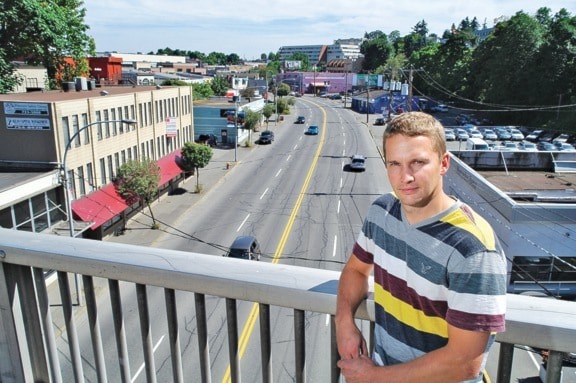Proponents of redevelopment along Terminal Avenue and Nicol Street corridor hope there is strength in numbers.
The Downtown Nanaimo Business Improvement Association received a $217,500 provincial grant to initiate Phase 1 of its planning, design and development committee’s project to overcome the challenges inhibiting business growth opportunities along the corridor.
Known as the Terminal Trench, the corridor was once a ravine running from the Pearson Bridge to Port Place shopping centre. It became the dumping ground in 1891 for not only debris from coal mines, but garbage from the community, and was eventually filled in by the early 1920s. (See our feature story on this here.)
The likelihood of contaminated soil beneath the nearly 100 properties lining the streets was an impediment to the corridor’s development for a number of years.
Darren Moss, committee chairman and project manager, said discovering what’s underneath the roads and how to deal with it could be a daunting task for individual property owners, so that’s why the committee is taking it on.
“We know what the historical uses have been and we know what the property owners have told us, but nobody really has an accurate picture of what is in that corridor today,” he said. “We need to know what is there and how to deal with it before we can steer our way clear.”
He said with the grant money and the power of roughly 60 property owners behind it, the committee is ready to proceed.
Environmental consultants Golder and Associates of Nanaimo was hired to collect information from the owners regarding the properties.
The committee also hopes to define and negotiate some of the broad-area challenges of the corridor with the Ministry of Environment.
“On a wide-area nature, you can have discussions with the ministry about the risk of the contaminants,” said Moss. “Those kind of discussions are difficult and costly for a single property owner. The goal of this project is to use the power of multiple property owners to have those discussions with the ministry and hopefully justify some concessions that make development easier going forward.”
Moss said the committee is interested in the big picture and a team effort is key to the project.
“The thing we are trying to do is steer clear of site-specific challenges,” he said. “The goal of this project is not to remediate someone’s underground oil tank or complete the remediation. It is to map the course for each individual owner and deal with the area-wide challenges.”
Response from property owners regarding Phase 1 has been cautious but improving, he said.
“Environmental contamination over the years has developed a fairly negative reputation, but the reality of development is you can’t divest yourself of your property without adequately addressing it,” he said. “I think the confidentiality of the information is key to a lot of owners. In the end, they are the only ones in control of their properties.”
The DNBIA partnered with the city and the Nanaimo Economic Development Corporation on the project, and A.J. Hustins, corporation board chairman, said receiving the grant and proceeding with Phase 1 is good news.
“We visited with an investor who had identified Nanaimo as a place he wanted to do some business and the first comment was both Nicol Street and Terminal Avenue need some attention,” he said. “For years, development along this critical corridor has stagnated and this is one very large step.
“When this opportunity came up to do some geotechnical work and identify what needed to be done for those property owners, the NEDC wanted to be supportive in anyway it could.”
Completion of Phase 1 is for scheduled for next spring, but Moss cautions it’s just the first step in a many-year development of the area.
“If I had a crystal ball, we would have at the end of Phase 1 an area-wide description of the challenges, positive discussions with the Ministry of Environment on strategies that reduce the area-wide requirements and a plan to take the property owners so they can see their way clear of the challenges,” he said.
Phase 2 is completely dependent on what is found in Phase 1.
"Once we’ve mapped out the technical challenges, we need to figure out how deal with the costs and what kind of incentives could be put in place for the property owners," Moss said.
